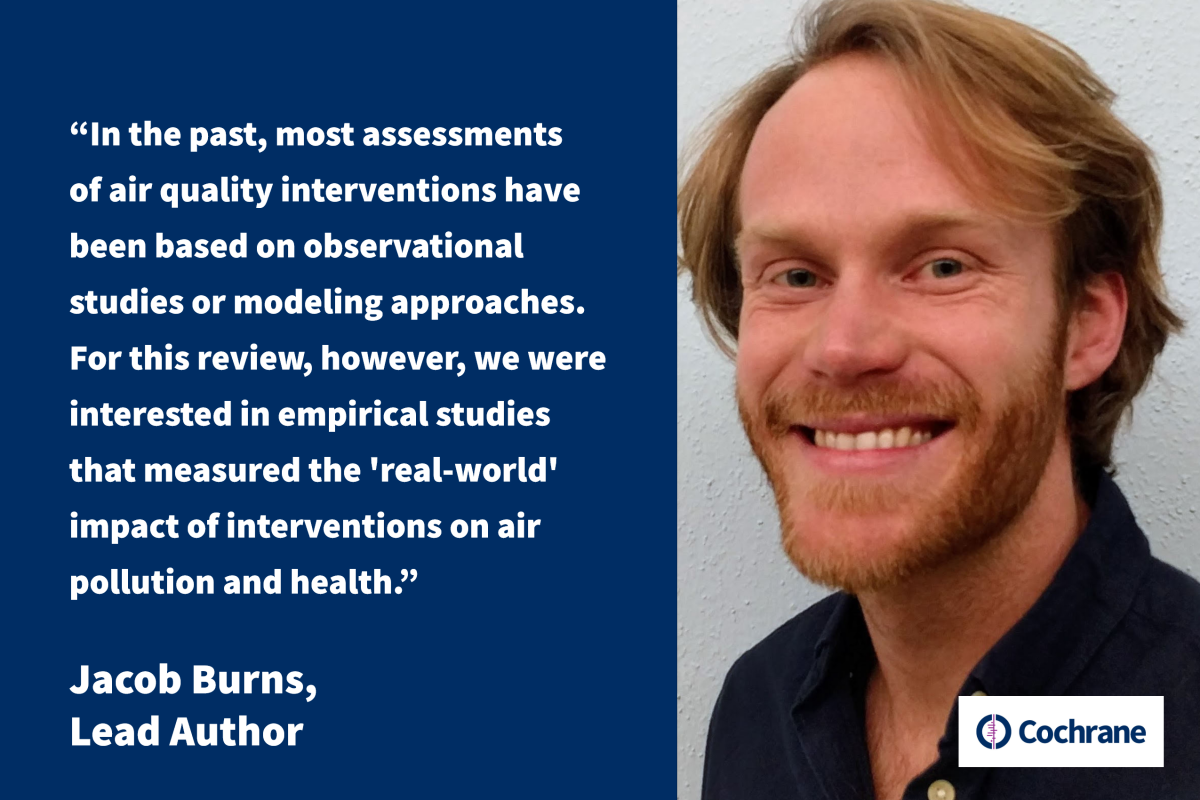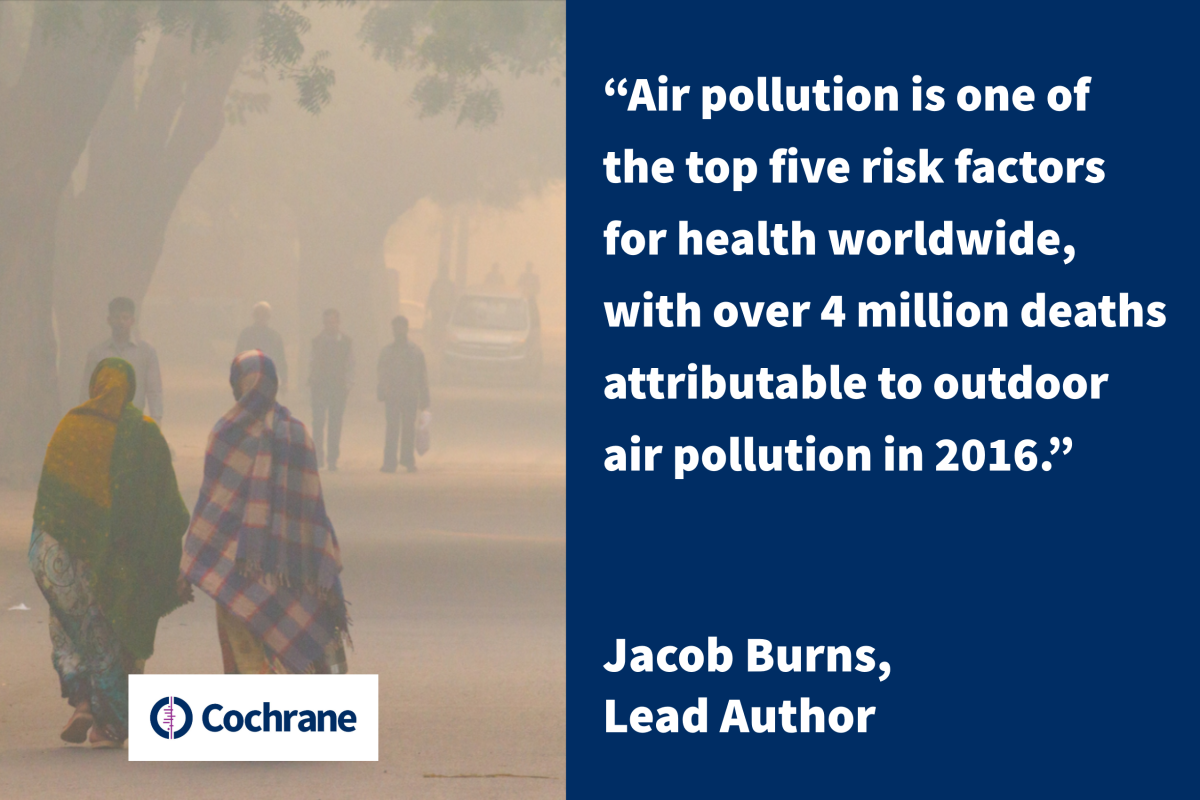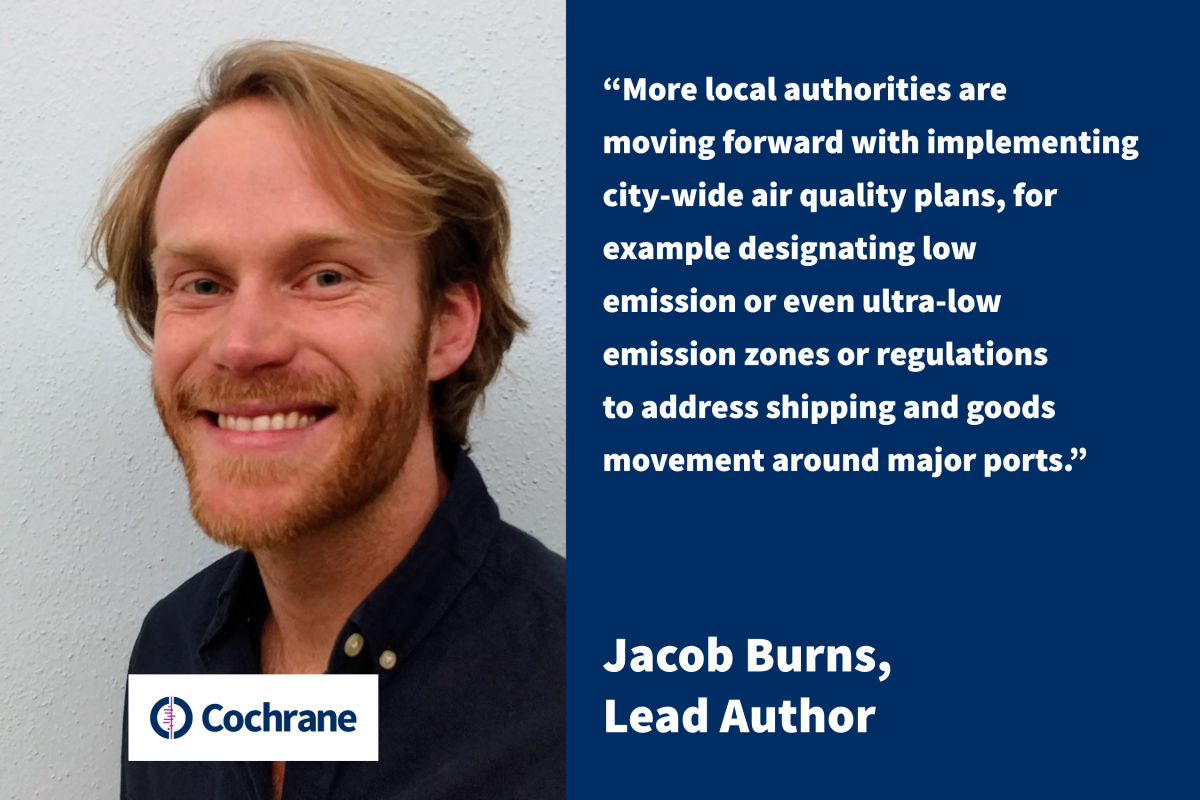
Air pollution is one of the top five risk factors for health worldwide. In this interview Jacob Burns lead author of a recent Cochrane Review on this topic tells us about the newly published Cochrane Review which set out to assess the effects of interventions on air pollution and health.
Tell us about this Cochrane Review…
Over the past several decades, thousands of studies have documented associations between ambient air pollution and mortality and morbidity. Strong evidence of health effects related to ambient air pollution has led to the adoption of air quality standards to protect public health. In order to meet those standards and improve air quality, a variety of interventions have been implemented across the globe (think standards for industry, standards for vehicles, changes to speed limits, introducing public transportation, restrictions on the burning of wood or coal, etc.). Typically, assessments of the benefits of air quality interventions are based on modeling approaches. For this review, however, we were interested in empirical studies (i.e. ‘real-world’ studies) assessing the effects of interventions on air pollution and health. These studies are referred to as intervention or accountability studies. To date, no systematic review of these studies using standardized and transparent review methods has been performed, so we set out to do so.

Why is this such an important topic?
Air pollution is one of the top five risk factors for health worldwide, with over 4 million deaths attributable to outdoor air pollution in 2016. The effect of particulate matter, as well as other criteria pollutants, on cardiovascular and respiratory health is well-documented, but the interactions of air pollution within the body are complex and several other negative health effects are also likely. Interest in assessing the health effects of air quality interventions has grown in response to questions about the benefit of further tightening air pollution regulations internationally and nationally, as well as implementing specific measures locally.

Does this review suggest that some interventions might work better than others?
Ideally, this review would be able to provide decision-makers with very specific information on which interventions are most effective in improving air quality and health (i.e. ‘what works and what does not work’). Conclusions of this nature were not possible, however, for several reasons, notably the following. First, the evidence base was quite fragmented, comprising a broad range of interventions targeting a variety of sources (i.e. industrial, vehicular, residential), implemented at different levels (e.g. local, national) and in different world regions; rarely were we able to assess multiple studies assessing the same set of interventions. Second, the included studies were methodologically very different from one another, varying greatly in quality. Third, detecting changes in air quality and population health is challenging, in particular when seeking to attribute observed changes to a single intervention.
What conclusions can be drawn from the evidence you identified?
Our overall findings can be summed up like this – most studies demonstrated that the impact of air quality interventions was either unclear or were associated with significant improvements in air quality or health. Importantly, we identified only very little evidence suggesting that interventions were associated with worsened health or air quality. This implies that, even where studies were unable to demonstrate substantial improvements in air quality or health as a result of an intervention, the risk of harms associated with this intervention is likely to be very low.
What is it that is particularly challenging about evaluating an intervention’s effectiveness on air quality and health?
Think of a specific example – a low emission zone restricting access of the most-polluting vehicles from the city center. Such an intervention may be introduced gradually, with tighter restrictions being implemented yearly. Enforcement of the low emission zone may also change over time, moving from leniency in the beginning to stricter enforcement over time, thereby bringing about change in a gradual rather than immediate manner. It is important to consider that, unrelated to the low emission zone, air quality and health are influenced by many other factors such as social and economic changes (e.g. fuel prices, number of vehicles, composition of vehicle fleet), weather patterns, health care, demographic and behavior changes. In addition, often multiple interventions are implemented within the same time frame, complicating the isolation of specific effects.
What does “lack of evidence of an association is not equivalent to evidence of no association” mean?
This is important for interpreting the results of our review. Both from the perspective of the review and from the individual studies, observing no clear association does not mean that such an association does not exist. We know, for example, from other research that air quality has improved substantially over several decades in most high income countries. Moreover, the relationships between outdoor air pollution and various health outcomes are classified ‘causal’, drawing on diverse lines of evidence including observational epidemiology, animal toxicology and human clinical studies.
Tell us about the importance of the methods of the individual studies, why is this important?
The results of any systematic review are completely dependent on the design and conduct of the studies included in the review. Thus, it was extremely important that we identify and communicate where included studies employed methods that may have introduced bias. We have done this through assessing the risk of bias of each study, and through assessing the risk of bias and other potential flaws across all studies. Learning from the strengths and weaknesses across studies, we have developed recommendations for improving evaluations of interventions to improve ambient air quality in the future.
So, ideally, how would individual studies evaluating outdoor air pollution be designed?
Although there are many aspects to consider, we would like to highlight two points that are of particular importance: rigorous control of confounding factors and prospective planning of evaluations.
Intervention or accountability studies represent the closest epidemiologic equivalent to randomized controlled trials. Nevertheless, given the complexity in the interventions and outcomes discussed above, accounting for important observed and unobserved confounders is critical. In particular, we recommend that intervention studies pay attention to selecting appropriate comparison populations or outcomes and to accounting for underlying background trends in air quality and health.
Most interventions of this type are implemented without a concrete evaluation plan, meaning that researchers are restricted to retrospectively assessing routinely collected data. Valid, retrospective studies are definitely possible, and we indeed identified many of these, but prospectively evaluating air pollution interventions would allow much more flexibility in how studies are designed and analyzed, and the data sources used in the evaluation.
How would you advise decision-makers looking at your review to inform decisions on outdoor air pollution?
There are several parts of the world for which we found few or no studies, including Africa, the Middle East, Eastern Europe, Central Asia, and Southeast Asia. It will be key to implement and evaluate interventions to improve air quality in these areas, as it remains important for other parts of the world. Choice of intervention, however, will be highly context dependent. For example, if a single pollutant source contributes overwhelmingly to air pollution, a single intervention targeting that source may be the best starting point. Where multiple sources contribute substantially to pollution, single interventions will probably fall short, and a more systemic, multi-component approach is likely to be necessary.
Also, more and more local authorities are moving forward with implementing city-wide air quality plans, for example designating low emission or even ultra-low emission zones or regulations to address shipping and goods movement around major ports. It will be very important to track such efforts and to evaluate their effects on air quality and health.

